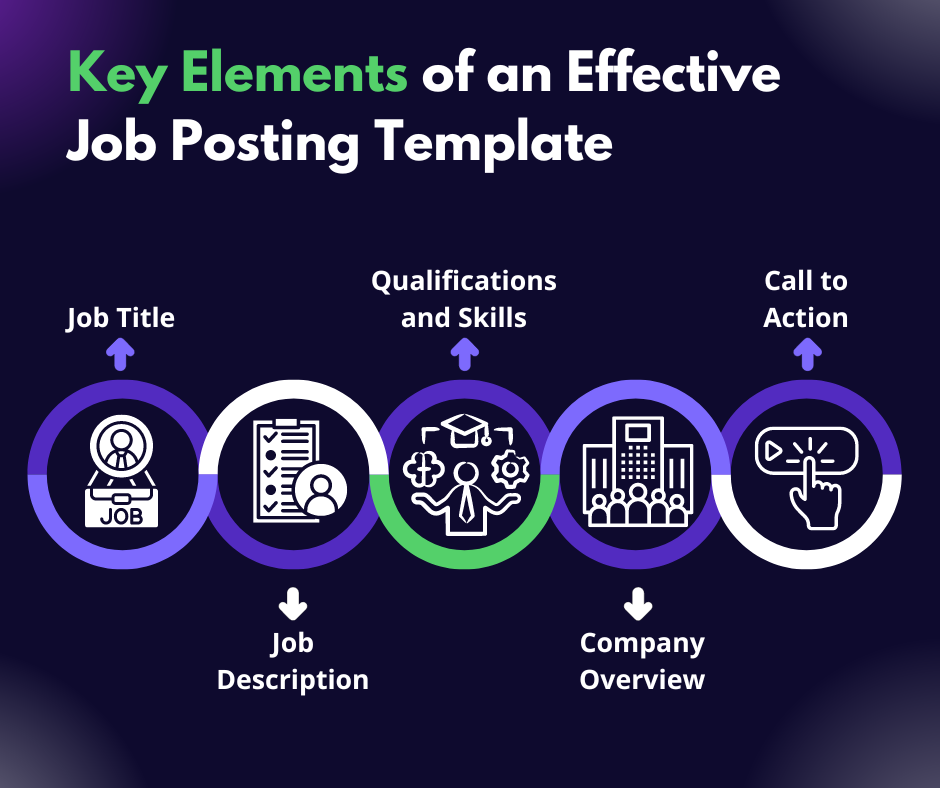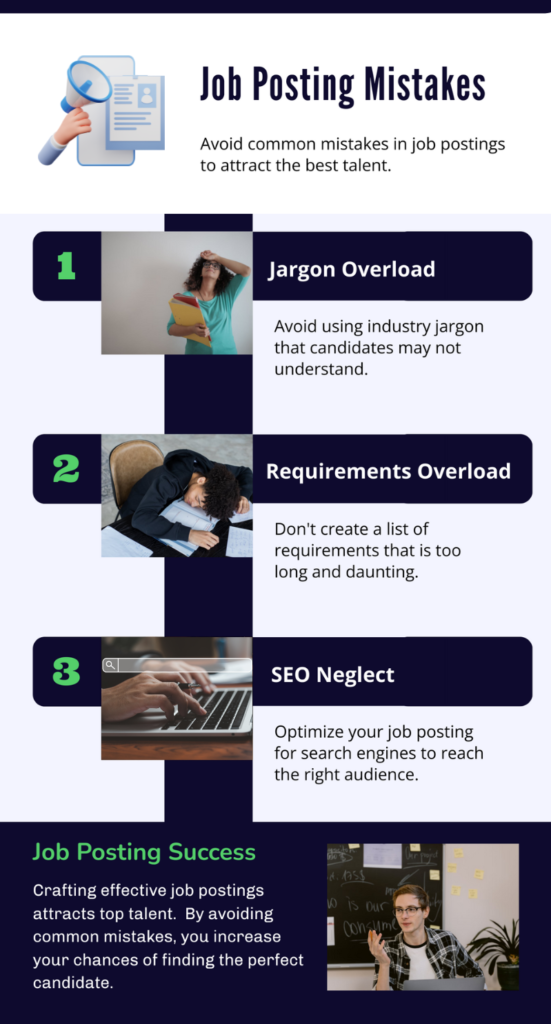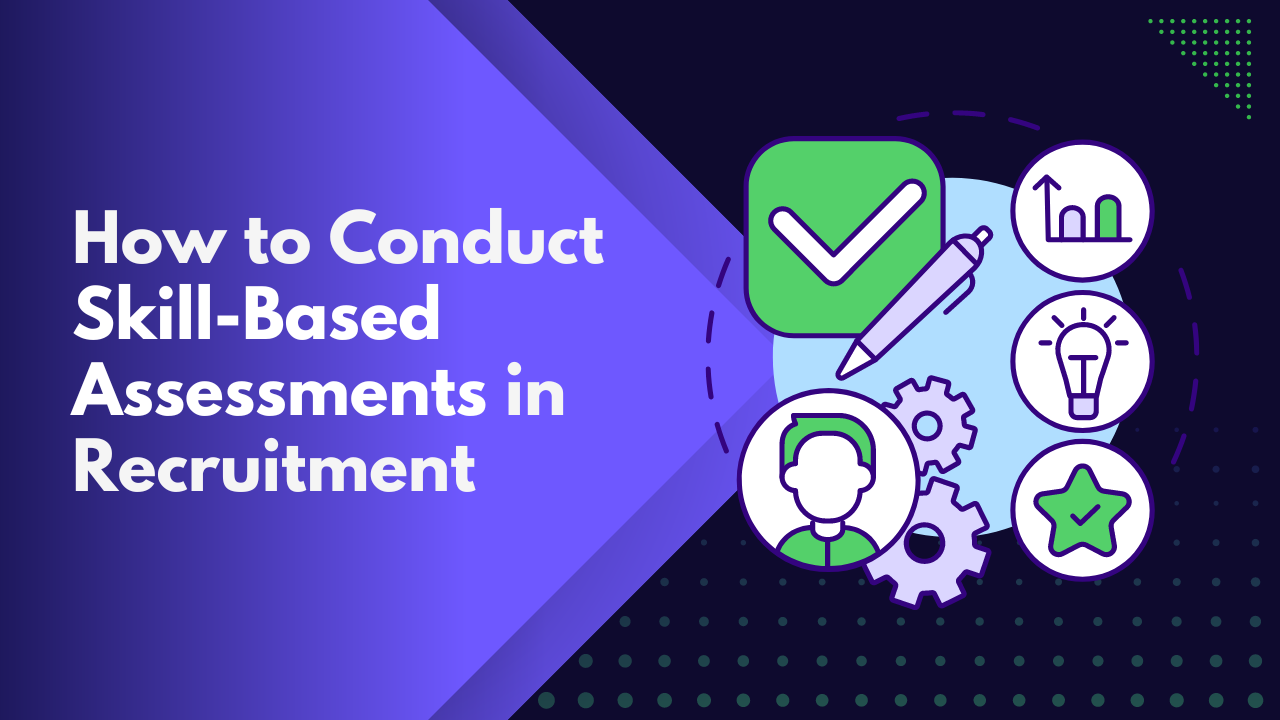Are you finding it challenging to draw in the ideal talent for your open positions? Perhaps it might not be the candidates; instead, it could be your job postings. A compelling job post is your first impression, and if it’s not engaging or clear, you might be missing out on the best fit for your team. In this article, we’ll explore how using a well-crafted job posting template can transform your recruitment efforts. Specifically, from streamlining your posting process to ensuring you attract qualified candidates, a solid template is more than just a convenience—it’s a game-changer.
We’ll dive into why optimized and strategic job posting templates are essential, dissect the key elements that make a job post stand out. Additionally, we’ll share tips on optimizing your postings for maximum visibility, and highlight common mistakes to avoid and provide examples tailored to different roles.
Ready to elevate your recruitment game? Let’s get started!
Why Job Posting Templates Are Your Secret Weapon for Attracting Top Talent
In today’s fiercely competitive talent market, a strong employer brand and a seamless candidate experience are non-negotiable. However, achieving these requires efficiency and consistency – two things that often feel impossible for busy HR teams. This is where the often-overlooked power of job posting templates comes in.
Don’t underestimate this simple tool. It’s not just about formatting; it’s a fundamental building block for attracting the best talent. Here’s why:
1. Consistency Breeds Trust (and a Stronger Brand)
Imagine a candidate browsing through multiple job postings from your company. Consistent job posting templates, with a unified tone of voice, style, and format, ensures a cohesive and professional experience. This strengthens brand recognition and conveys that you’re an organization that values attention to detail.
2. Enhance the Candidate Experience from the Start
Candidates shouldn’t have to decipher different layouts or writing styles when exploring opportunities. Templates provide familiarity and make it easy for potential hires to find the information they need quickly. Consequently, this streamlined experience makes a positive impression and keeps candidates engaged.
3. Efficiency is Key: Reclaim Valuable Time
Time is a recruiter’s most valuable asset. Instead of reinventing the wheel with each new opening, templates provide a reusable framework that saves you time and effort. As a result, you can focus on what matters most: finding the perfect fit for the role.
4. Streamline Collaboration, Eliminate Confusion
When multiple stakeholders are involved in the hiring process, a template keeps everyone on the same page. It provides a standardized structure for collaborating on job descriptions, ensuring alignment on key requirements and consistent messaging across the board.
5. Showcase Your Employer Brand, Attract the Right Fit
A well-structured job posting template offers a dedicated space to let your employer brand shine. Use this opportunity to highlight your company culture, values, and mission. In doing so, you can proactively attract candidates who align with your brand identity and are more likely to thrive in your environment.
Key Elements of an Effective Job Posting Template
Crafting an effective job posting goes beyond just filling in the blanks. It requires a strategic approach to ensure you attract the right candidates who are not only qualified but also excited about your opportunity. Here’s how to enhance your job posting templates with some unique and actionable tips:

1. Job Title: Crafting a Clear and Attractive Title
The job title isn’t just a label—it’s a powerful tool for catching the right candidate’s eye. To make your title stand out:
- Be Specific and Descriptive: Avoid generic titles. For example, instead of “Marketing Specialist,” use “Digital Marketing Specialist with Expertise in Content and SEO.” This helps attract candidates who are specifically looking for roles that match their skills.
- Consider Seniority: Use terms like “Junior,” “Mid-Level,” or “Senior” to attract the right experience level.
- Incorporate Keywords: Use keywords that potential candidates might search for. This not only makes your posting more discoverable but also helps filter in candidates who are genuinely interested in that role.
2. Job Description: Including Essential Duties and Responsibilities
A compelling job description is more than just a list of tasks—it’s an opportunity to sell the role to potential candidates. Here’s how to make it engaging:
- Start Strong: Begin with a hook – a concise and captivating paragraph that highlights the role’s purpose, impact, and potential for growth.
- Outline Key Responsibilities: Use strong action verbs and clear, concise language. Focus on the most critical duties, avoiding overwhelming detail.
- Candidate-Centric Approach: Write from the candidate’s perspective. Instead of simply listing tasks, explain how their skills will be utilized and the impact they can make.
- Highlight Growth Opportunities: Mention potential career paths or opportunities for learning and development within the role or company.
- Example:
- Instead of: “Responsible for posting jobs online and screening resumes.”
- Use: “As a Talent Acquisition Specialist, you’ll play a key role in leveraging our cutting-edge AI platform to source and engage top talent from a global pool of 800 million+ professionals. You’ll drive the end-to-end recruitment process, from crafting compelling job descriptions to conducting initial screening interviews, ensuring we connect with the best candidates for our rapidly growing team.”
- Impact: A well-written job description increases candidate engagement and encourages applications from individuals who resonate with the role and company culture.
3. Qualifications and Skills: Highlighting Must-Have and Nice-to-Have Skills
When listing qualifications and skills, it’s important to balance clarity with encouragement:
- Separate Must-Haves from Nice-to-Haves: Use clear headings or formatting to distinguish between essential and preferred qualifications.
- Be Specific and Actionable: Use concrete examples to describe skills. Instead of “excellent communication skills,” say “Proven ability to deliver clear and concise presentations to executive stakeholders.”
- Quantify Experience: Instead of “Experience with project management,” say “2+ years of experience leading cross-functional project teams.”
4. Company Overview: Briefly Introducing Your Company and Culture
Your company overview should do more than just introduce your company; it should entice candidates by showcasing what makes your company a great place to work:
- Share Your Mission and Impact: Highlight how your company’s mission aligns with candidates’ values. For example, “Join us in our mission to revolutionize sustainable fashion and make a positive impact on the environment.”
- Include Employee Testimonials: Add a short quote or testimonial from current employees about what they love about working at your company. This adds authenticity and helps candidates connect with your company culture.
5. Call to Action: Encouraging Candidates to Apply
A strong CTA can significantly increase the likelihood of receiving applications:
- Create a Sense of Urgency: Use phrases like “Apply by [date] to be considered for this exciting opportunity” to encourage prompt action.
- Offer a Sneak Peek: Provide a glimpse of the next steps in the hiring process. For instance, “Submit your resume to our team, and if we’re a fit, you’ll hear from us within two weeks for a chat about how you can make an impact.”
Optimizing Your Job Postings for Search Engines: A Practical Guide
Finding the perfect candidate is like finding a needle in a haystack. However, what if you could make the haystack smaller and the needle glow brighter? That’s precisely what SEO optimization for job postings does.
In this guide, you will be equipped with actionable strategies to make your job postings easily discoverable by both candidates and search engines like Google, as well as job boards like LinkedIn. By implementing these strategies and using recommended job posting templates, you’ll not only attract a wider pool of qualified candidates but also improve your chances of making a successful hire.
1. Speak Your Candidate’s Language: Keyword Research
Before you write a single word, step into your ideal candidate’s shoes. What words would they use to find your job opening?
- Utilize free keyword research tools:
- Google Keyword Planner: Uncover search volume for specific keywords related to job titles, skills, and industry terms.
- LinkedIn Search: Analyze suggested searches and profiles to identify commonly used terms.
- Job Boards: Browse relevant job boards and observe keywords used in similar job postings.
- Create a keyword list: Include a mix of:
- Job titles (both common and industry-specific): e.g., “Content Marketing Manager,” “Social Media Specialist”
- Hard skills: e.g., “SEO,” “PPC,” “Google Analytics”
- Soft skills: e.g., “communication,” “problem-solving,” “teamwork”
- Location (if applicable)
2. Craft a Captivating Job Title: First Impressions Matter
Your job title is the first thing candidates see. Make it count!
- Clarity is key: Use a job title that accurately reflects the role.
- Incorporate relevant keywords: Naturally weave 1-2 primary keywords, ideally towards the beginning.
- Avoid jargon and abbreviations: Stick to industry-standard terms.
- Front-load important information: Place the most crucial keywords and information first.
Example:
- Ineffective: “Marketing Guru – Rockstar”
- Effective: “Senior Digital Marketing Manager – SEO Specialist”
3. Structure for Readability and SEO: Make it Easy on the Eyes
- Use clear headings and subheadings: Break up text into logical sections using descriptive headings that include relevant keywords.
- Embrace bullet points: Present key responsibilities, qualifications, and benefits in bullet points for easy scanning.
- Short paragraphs are your friend: Aim for paragraphs no longer than 3-4 sentences.
- Bold important keywords: Strategically bold a few key skills or qualifications within the text to draw attention.
- Write conversationally: Avoid overly formal language or jargon.
4. Optimize for Mobile Devices: On-the-Go Applications
- Use a mobile-friendly job posting template or platform.
- Optimize images: Compress images to ensure fast loading times.
- Choose legible font sizes.
- Test on multiple devices.
The Impact: A Win-Win for You and Your Candidates
By implementing these SEO strategies, you’ll:
- Increase visibility in search engine rankings and on job boards.
- Attract more qualified candidates who possess the specific skills and experience you’re seeking.
- Reduce time-to-hire by attracting a larger pool of relevant applicants.
- Enhance your employer brand by demonstrating a commitment to a positive candidate experience.
Start optimizing your job postings today and watch the right talent come to you!
Common Job Posting Mistakes to Avoid

Ditch the Jargon: Speak Your Candidate’s Language
While you may live and breathe your industry’s terminology, chances are your potential candidates don’t. Overloading your job postings with technical jargon and overly formal language can make them sound inaccessible and intimidating.
Example:
- Instead of: “Utilize agile methodologies to spearhead cross-functional team initiatives.”
- Use: “Collaborate with different teams to develop and launch projects using agile methods.”
Keep it clear, concise, and conversational. Write your job postings in a way that anyone can understand, regardless of their background.
Don’t Scare Them Away: Finding the Right Balance of Requirements
It’s tempting to list every skill and qualification under the sun in hopes of finding the “perfect” candidate. However, a laundry list of “must-haves” can actually deter perfectly capable individuals.
Focus on the essential skills and experience truly critical for success in the role. Differentiate between “must-haves” and “nice-to-haves” to provide a clearer picture without being overly restrictive.
Get Found by the Right Talent: Don’t Let SEO Be an Afterthought
You’ve crafted the perfect job posting, but what if it gets lost in the internet abyss?
Optimizing your job postings for search engines like Google and LinkedIn is crucial for attracting the right talent. Here’s how:
- Keyword Research: Use tools like Google Keyword Planner to identify relevant terms candidates use when searching for similar roles.
- Job Title Optimization: Incorporate these keywords naturally into your job title while keeping it concise and engaging.
- Format for Readability: Use clear headings, subheadings, and bullet points to improve readability (for both humans and search engines!).
- Mobile Optimization: Ensure your job postings look great on smartphones, as many job seekers are on the go.
High-Converting Job Posting Templates
Here are two job posting templates, one tailored for a tech role and another for a creative role, incorporating the best practices outlined:
Tech Role Template: Senior Backend Developer
About [Your Company Name]
[Write a brief and engaging company overview that highlights your tech stack and culture of innovation. Example:
We’re a fast-growing tech company revolutionizing the [your industry] industry. Our team of passionate engineers thrives on using cutting-edge technologies to build scalable solutions that impact millions of users daily. We work with Python, Django, React, AWS, and are strong advocates for open-source contributions. If you’re driven by solving complex challenges and want to make a real difference, join us!]
About the Role
Are you passionate about building the backbone of high-performance applications? Do you thrive in a collaborative environment where you can contribute to building and scaling systems used by millions of users? If so, this role is for you!
As a Senior Backend Developer, you’ll be instrumental in designing, developing, and implementing key features for our core platform. You’ll work closely with our product and engineering teams to bring innovative ideas to life.
Responsibilities:
- Design, develop, and implement RESTful APIs using Python and Django
- Write clean, efficient, and well-tested code
- Collaborate with cross-functional teams to define and implement new features
- Optimize application performance and ensure scalability
- Contribute to the continuous improvement of our development processes
Must-Have Skills:
- 5+ years of experience in software development
- Expertise in Python, Django, and RESTful APIs
- Experience with relational databases (PostgreSQL, MySQL)
- Strong understanding of software design principles and best practices
- Excellent communication and collaboration skills
Nice-to-Have Skills:
- Experience with cloud platforms (AWS, Azure, GCP)
- Familiarity with DevOps practices and tools
- Contributions to open-source projects
What We Offer:
- Competitive salary and benefits package
- Opportunity to work with cutting-edge technologies
- Flexible work arrangements
- Professional development opportunities
- A collaborative and supportive team environment
Ready to make an impact? Apply Now!
[Link to Careers Page or Application Email Address]
Creative Role Template: Senior UX Designer – SaaS Products
About [Your Company Name]
[Write a brief and engaging company overview that highlights your brand’s visual identity and collaborative creative environment. Example:
We’re a design-driven company passionate about creating beautiful and intuitive SaaS products that solve real-world problems. Our team is a tight-knit group of creative thinkers who thrive on collaboration and pushing the boundaries of user experience. If you’re passionate about making a visual impact and want to be part of a team that values your creativity, join us!]
About the Role
Are you obsessed with user-centered design and passionate about creating seamless digital experiences? Do you have an eye for detail and a knack for transforming complex concepts into intuitive interfaces? If so, we want to hear from you!
As a Senior UX Designer, you’ll be a key player in shaping the user experience of our flagship SaaS products. You’ll work closely with product managers, engineers, and other designers to bring innovative ideas to life.
Responsibilities:
- Conduct user research to understand user needs and pain points
- Develop user flows, wireframes, and interactive prototypes
- Design high-fidelity mockups and create intuitive user interfaces
- Collaborate with UI designers to ensure a cohesive visual experience
- Conduct usability testing to gather feedback and iterate on designs
Must-Have Skills:
- 3+ years of experience as a UX/UI Designer for SaaS products
- Proficiency in design tools such as Figma, Sketch, and Adobe Creative Suite
- A strong portfolio showcasing a deep understanding of user-centered design principles
- Excellent communication, presentation, and collaboration skills
Nice-to-Have Skills:
- Experience with front-end development (HTML, CSS, JavaScript)
- Familiarity with Agile methodologies
Why Join Us:
- Opportunity to work on challenging and impactful projects
- Creative freedom and a collaborative team environment
- Competitive salary and benefits
- Inspiring workspace designed to foster creativity
- Opportunities to attend industry events and workshops
Ready to unleash your creativity? Submit your portfolio and resume today!
[Link to Careers Page with Portfolio Submission Instructions]
Conclusion
In conclusion, crafting compelling job postings is not just an option but a necessity in today’s competitive talent market. Remember, your job posting is often the first impression potential candidates have of your company – it’s your chance to showcase your brand and attract top talent. By implementing a job posting templates that incorporates strategic elements and avoids common mistakes, you can boost the visibility of your posts, streamline the recruitment process, and connect with top talent faster. So, don’t just fill positions—build a team that propels your business forward. Start using a job posting template today and transform the way you attract talent!
Related Posts
- hiring process
- How to Post a Job
- Job Listings
- Job Posting Template
- Recruitment
Content
- Why Job Posting Templates Are Your Secret Weapon for Attracting Top Talent
- Key Elements of an Effective Job Posting Template
- Optimizing Your Job Postings for Search Engines: A Practical Guide
- Tech Role Template: Senior Backend Developer
- Creative Role Template: Senior UX Designer - SaaS Products
- Conclusion




